At Watches and Wonders Geneva 2024, Jaeger-LeCoultre presented the sensational Duometre Heliotourbillon Perpetual. Price €400,000
Introduced in 2007, the Duometre concept was developed to ensure that adding complications to a movement would not affect its accurate timekeeping. In fact, the fundamental requirement of precise timekeeping is that the power supply from the movement’s barrel to the escapement should be absolutely steady. However, in order to operate, a complication must draw on the power supply, which interrupts that steady flow, thus jeopardising precision.
The Duometre concept, initially introduced in 2007, aimed to preserve accurate timekeeping even with the addition of complications. Maintaining a constant power supply from the movement's barrel to the escapement is crucial for precise timekeeping. However, adding complications typically interrupts this steady flow, posing a challenge to precision.
The patented Duometre mechanism features two barrels and two separate gear trains housed in a single calibre and linked to a single regulating organ. One gear train powers the time indications and the other drives all additional functions. Each barrel guarantees a power reserve of 50 hours. By separating the power supply in this way, the Duometre mechanism guarantees an exceptionally high degree of operating accuracy.
Together with the innovative tourbillon, the Duometre Heliotourbillon Perpetual introduces an entirely new case design that will define all the upcoming timepieces in the revamped Duometre collection, including the new Duometre Quantieme Lunaire and the new Duometre Chronograph Moon, also unveiled at the Watches and Wonders exhibition (stay tuned for detailed descriptions of these models in upcoming articles).
A modern reinterpretation of the savonette pocket watches crafted by the Maison in the 19th century (the French word savonette literally means a small disc of soap with rounded contours that can be cradled in the palm of a hand), the new case features rounded contours, a convex crystal, and a gracefully rounded bezel, aligning seamlessly with this historical definition.
The crown, too, has been redesigned, with deep and rounded notches. The only sharp lines to be found are on the highly polished edges of the lugs.
Measuring 44 mm in diameter with a thickness of 14.7 mm, the 18 carats pink gold case consists of 34 separate parts, with the lugs screwed instead of integrated to facilitate various finishing techniques. A blend of polished, brushed, and micro-blasted surfaces produces an intriguing interplay of light with each wrist movement. Water resistance is ensured up to a pressure of 3 bar.
Beating at a frequency of 4Hz (28,800 vibrations per hour) to further enhance chronometry, the new hand-wound Calibre 388 incorporates almost eight decades of accumulated expertise in the tourbillon regulating mechanism. As written in the introduction, the newly developed tourbillon rotates on three axes, creating a unique spinning top effect.
Originally designed for pocket watches, traditional tourbillons do not fully counteract gravity's effects in all positions. Recognising this limitation, Jaeger-LeCoultre engineers developed the dual-axis Gyrotourbillon and other tourbillon configurations with different hairspring shapes to address the issue.
Fitted with a cylindrical hairspring, the Heliotourbillon takes this approach further, with a newly developed construction comprising three titanium cages rotating on three different axes. The first cage is set at a 90-degree angle to the balance wheel and rotates perpendicular to it. The second cage is set at 90 degrees to the first (thus, on the same plane as the balance wheel). Together, these two cages are constrained by an axis tilted at 40 degrees and make a full rotation in 30 seconds.
The third cage is perpendicular to the second and makes a full rotation in 60 seconds. Supported on ceramic ball bearings to minimise friction, the tourbillon consists of 163 components and weighs less than 0.7 grams.
Calibre 388 also integrates a sophisticated perpetual calendar mechanism, automatically adjusting for months of different lengths and for leap years. It will need manual correction of the day and date indications only in 2100 and in subsequent centenary years that are not also leap years.
A feature of the new movement is that, differently from most perpetual calendars where adjusting the time backwards desynchronises and can damage the calendar mechanism, in this case the hours and minutes can be set either backwards or forwards without compromising the perpetual calendar.
Other notable features of Calibre 388 include a Grande Date display, positioned at 3 o'clock on the hours-and-minutes sub-dial, the year indication which shows the last digit of a leap year in red (a Jaeger-LeCoultre patent), and the moon-phase display, accurate to 122 years.
Like all Jaeger-LeCoultre movements, Calibre 388 was conceived, designed, produced, assembled and finished within the Manufacture.
The symmetrical layout of the dial adopts a triangular configuration, with the winding crown forming the apex of the triangle and the ‘base’ of the triangle being formed by the moon-phase indicator and days on one side and the months and years on the other.
On the vertical axis, the two sides of the dial are separated by a gold bridge with contrasting areas of microblasting and bevelling. The left-hand side of the dial is open-worked to showcase the mesmerizing rotation of the tourbillon.
Additionally, a sapphire crystal window on the case side provides another perspective to admire this captivating mechanical spectacle.
The tourbillon is set above a background of deep blue lacquer representing a starry sky and, as it spins, red triangles set on the third cage indicate 20-second intervals marked on a sapphire crystal arc that floats above the starry blue background.
The different sectors of the dial are highlighted by a mix of opaline, brushed and azuré surfaces.
This fine decoration is carried over to the movement, even on components that are not visible through the sapphire crystal caseback: brushed surfaces contrast with perlage, edges are hand-bevelled and polished, and sunrayed Geneva stripes (Côtes de Genève soleillées) radiate across the bridges.
Paired with a brown alligator leather strap with small-scale alligator lining, the new Jaeger-LeCoultre presents the Duometre Heliotourbillon Perpetual, ref. Q6202420, is priced at Euro 400,000 (before sales taxes) and available in a limited run of just 20 pieces. jaeger-lecoultre.com
Suggested reading:




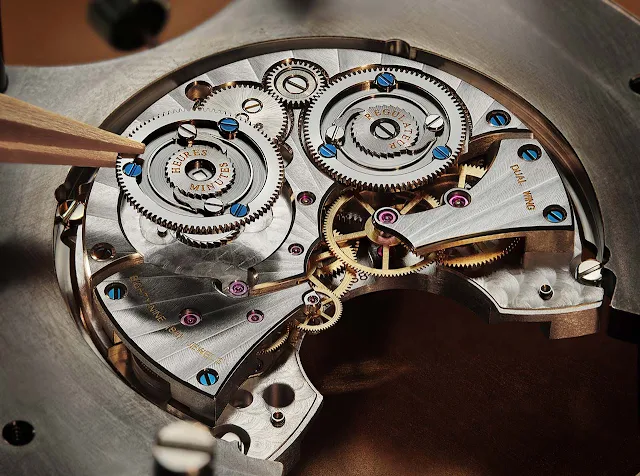


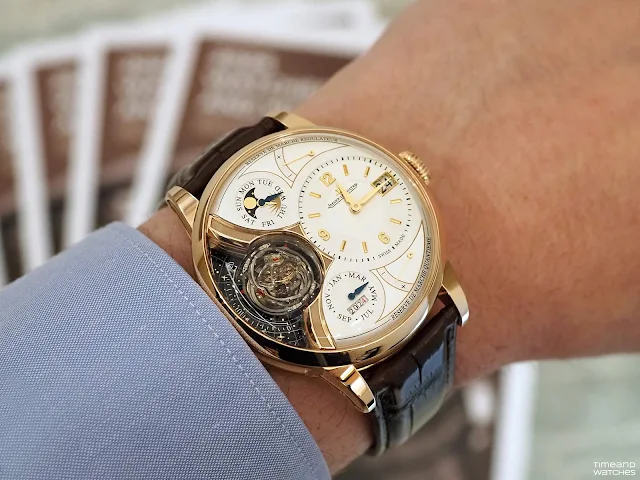
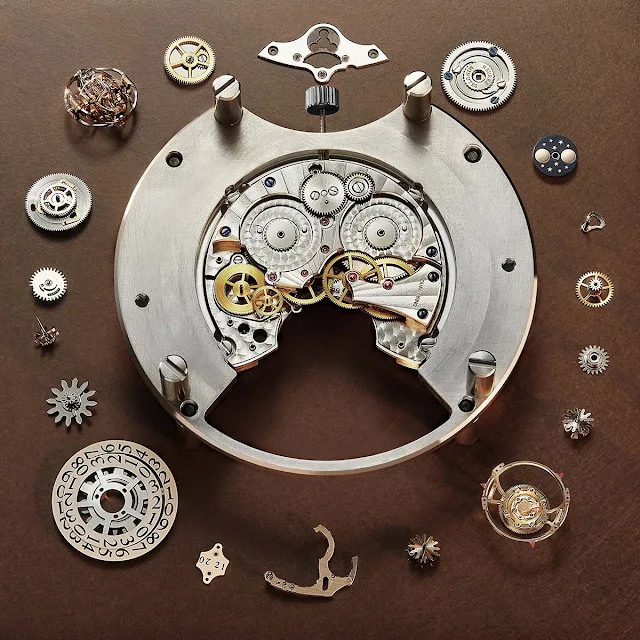

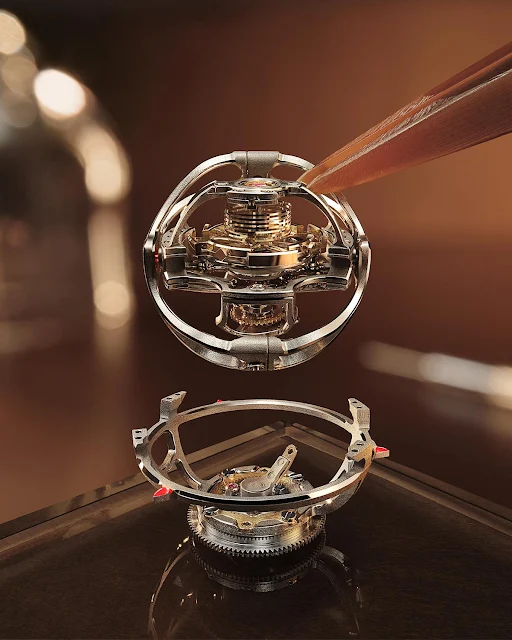
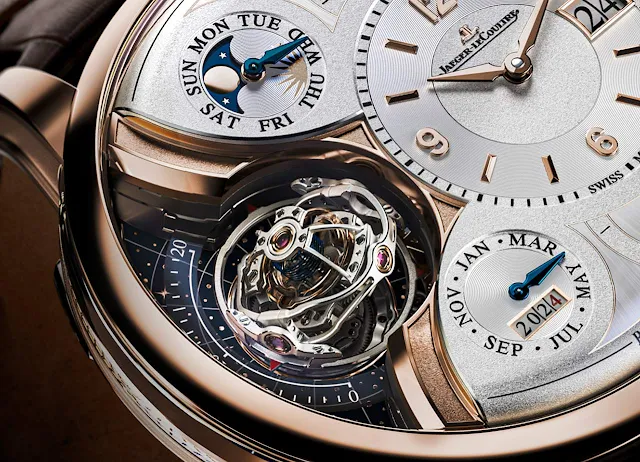
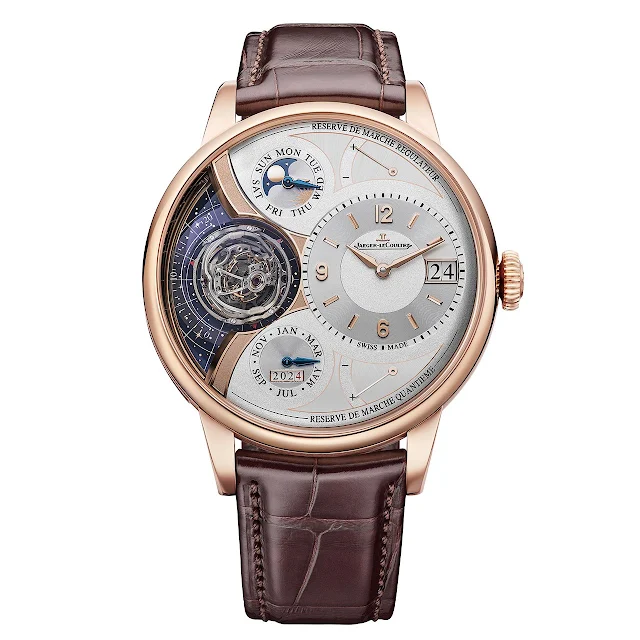
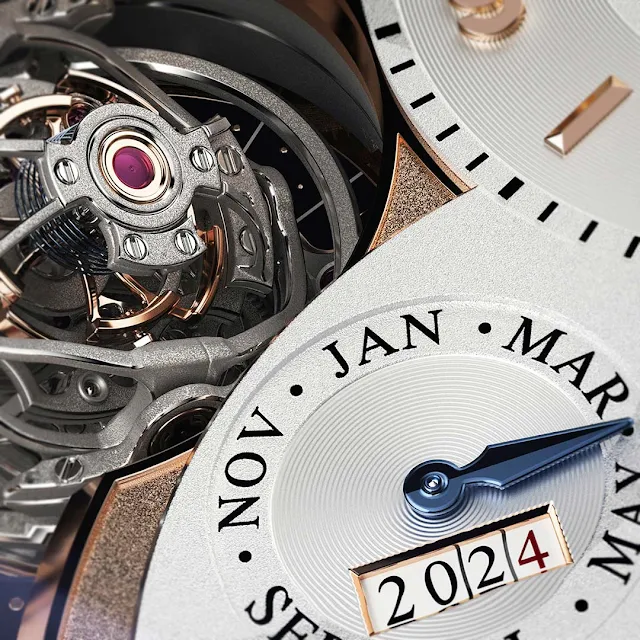

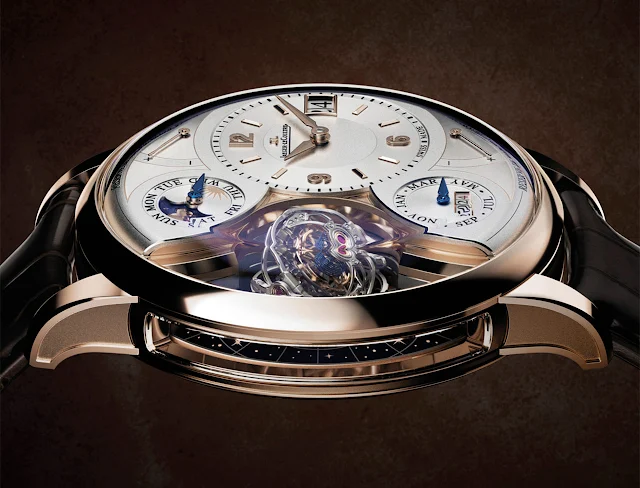









The beauty of mechanics!
ReplyDelete